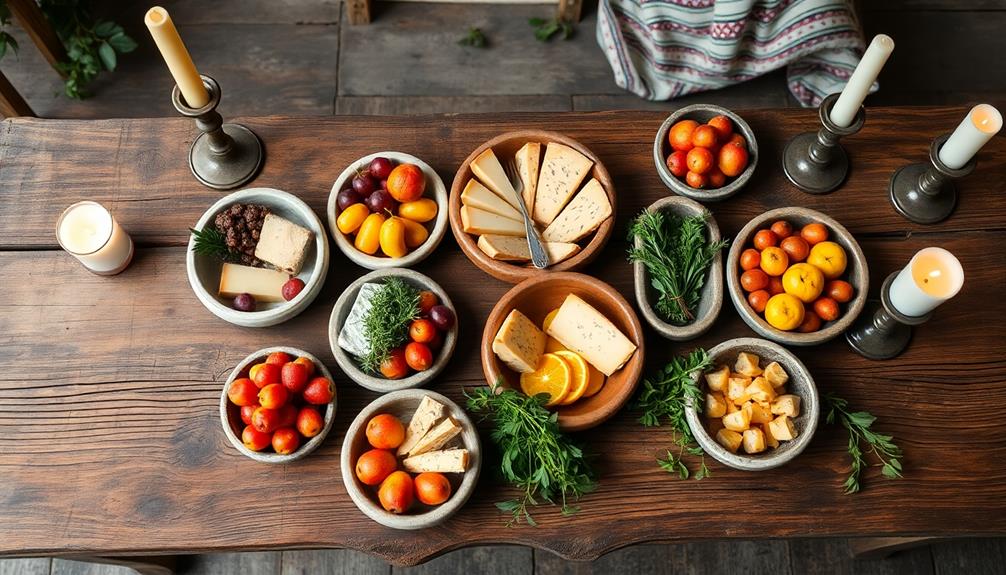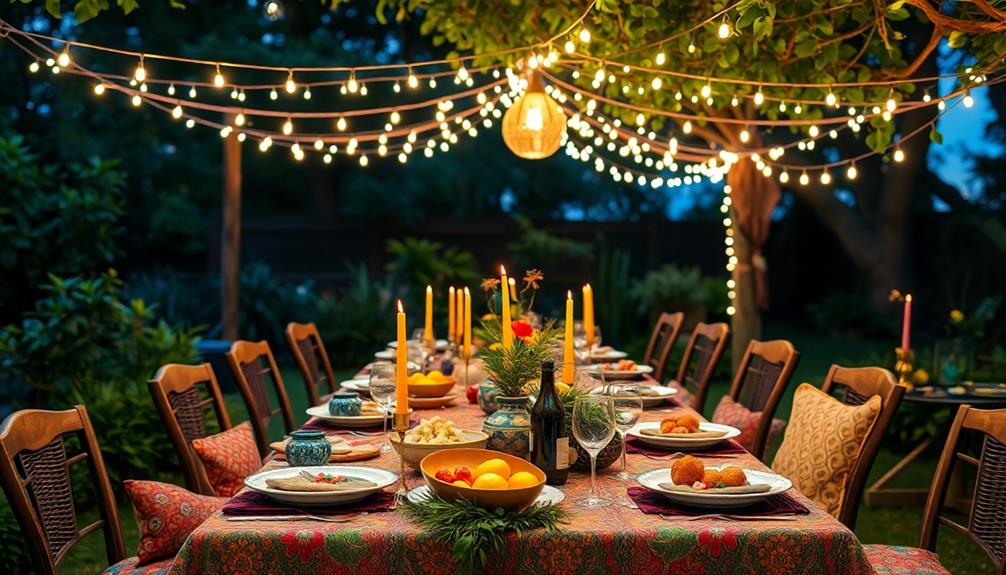To style food for Instagram in a Boho theme, embrace vintage pieces and earthy tones for a relaxed vibe. Use neutral-colored props to minimize distractions, letting your food shine. Layer your table with ethnic-patterned cloths and eclectic dishware to create visual interest. Incorporate handcrafted details like macramé or decorative herbs to enhance texture. Consider mini serving styles and interactive dining experiences for an inviting touch. Don't forget to highlight seasonal ingredients and dietary inclusivity for a broader appeal. If you're curious about more tips and tricks, there's plenty more you can explore to elevate your food styling game.
Key Takeaways
- Use vintage and handcrafted serving pieces to add character and enhance storytelling in your food presentation.
- Incorporate earthy tones and natural fabrics to create a cohesive and warm aesthetic that aligns with the Boho style.
- Layer ethnic-patterned tablecloths with contrasting textures for visual interest and a relaxed vibe in your food displays.
- Utilize natural light to enhance the appeal of your dishes, making them more inviting and shareable on social media.
- Clearly label dishes with eye-catching signage to inform guests about dietary preferences and enhance the overall dining experience.
Understanding the Boho Aesthetic
The Boho aesthetic is all about combining a relaxed vibe with modern retro elements to create a unique and inviting atmosphere. When you're styling food for Instagram, think about how vintage pieces can enhance your presentation. Incorporating handcrafted details like lace and crochet not only adds texture but also a personal touch that resonates with the Boho theme.
Opt for natural fabrics like linen or cotton for your table settings, which provide a soft, flowing appearance. Layering decor is key—use ethnic-patterned tablecloths and varying heights with display risers to create visual interest.
Earthy tones and rustic materials, like burlap runners or wooden boxes, keep your styling cohesive while adding warmth to your setup.
To truly capture the Boho spirit, consider using printed cloths with tribal patterns or florals that echo a sense of world travel. This approach not only elevates your food styling but also invites your audience into a story.
Essential Props and Backgrounds

To truly enhance your food styling and capture that Boho vibe, choosing the right props and backgrounds is key. By selecting items that resonate with the aesthetic, you'll elevate your photography and create a fascinating visual story. Here are some essential elements to reflect on:
- Neutral-colored props: Opt for ceramics from Sarah Kersten Studio to minimize reflections and highlight the natural beauty of your food. Additionally, reflect on using natural textures, such as deterring scratches on your furniture, to keep your setup looking polished.
- Versatile backgrounds: Use lightweight, double-sided boards from Erickson Surfaces or reclaimed wood from Etsy to complement your dishes.
- Layered decor: Start with natural or ethnic-patterned tablecloths as a base, then add contrasting textures like lace or crochet for a relaxed feel.
- Unique serving pieces: Choose vintage or handmade items instead of fine china to add character and tell a story.
Incorporating these props and backgrounds won't only enhance your food styling but also help you capture that whimsical, bohemian essence.
Creative Food Display Ideas

When it comes to showcasing your culinary creations, thinking outside the box can elevate your food display to new heights. Incorporating macramé hanging baskets adds a whimsical touch, perfect for elevating treats or napkins. Use natural materials like woven baskets and flowing fabrics to craft visually appealing arrangements that draw the eye and create texture.
Consider adding elements of Boho Chic Bedroom Decor by combining eclectic patterns in your tablecloth or napkins for an extra layer of interest. To enhance your boho setting, mix earthy tones and vintage serving pieces. This combination adds rustic charm while maintaining a cohesive aesthetic that shines in food photos.
Consider utilizing edible centerpieces, like vibrant fruit or fragrant herb arrangements, which serve a dual purpose; they're both decorative and delicious, perfectly aligning with the boho theme.
Don't forget to inspire guest participation! Establishing interactive food stations, such as grazing tables, not only encourages mingling but also adds variety to your presentation.
Interactive Dining Experiences

Interactive dining experiences transform ordinary meals into memorable events, engaging guests in the culinary process.
By incorporating fun elements, like best beach bags for moms for easy transport of snacks, you'll not only elevate the atmosphere but also create opportunities for guests to connect over their shared love of food.
Here are some ideas to enhance your dining experience:
- DIY food stations: Set up build-your-own taco or dessert bars where guests can customize their meals, adding a personal touch to their plates.
- Live cooking demonstrations: Allow guests to watch and interact with chefs as they prepare dishes, providing an entertaining and educational element to your event.
- Cocktail mixing stations: Encourage guests to experiment with different flavors and create their own unique drinks, making each sip a personal experience.
- Grazing tables: Display a colorful array of visually appealing items that promote sharing and conversation, making the dining experience more communal.
These interactive dining experiences not only create engaging moments but also lead to stunning photos of food that guests will want to share on Instagram.
Embrace these ideas to make your event unforgettable!
Trending Presentation Techniques

When it comes to Instagram-worthy food, miniature serving styles and deconstructed dish arrangements are leading the way.
These trends not only make your plates visually appealing but also invite your guests to explore different flavors and customize their meals.
Miniature Serving Styles
Miniature serving styles are taking the food presentation world by storm, transforming ordinary meals into playful, shareable experiences. These modern boho techniques encourage tasting and sharing among guests, creating an interactive dining atmosphere that aligns perfectly with the communal spirit of the boho aesthetic.
Incorporating natural elements, such as decorative herbs or edible flowers, can enhance the overall presentation and promote tranquility at the dining table calming decor.
To elevate your miniature servings, consider these tips:
- Use eclectic dishware: Vintage-inspired jars and small plates add charm and personality to your presentation.
- Incorporate vibrant colors: Colorful platters or tiered stands create visual contrast that not only attracts attention but also stimulates appetite.
- Artistic arrangements: Neatly stacked ingredients or playful groupings showcase your culinary creativity while enhancing the dining experience.
- Encourage customization: Deconstructed dishes served in petite portions allow guests to personalize their bites, making the meal even more engaging.
Deconstructed Dish Arrangements
Deconstructed dish arrangements are redefining how we present food, inviting guests to engage with their meals in a more personal way. This innovative approach emphasizes the individual components of a dish, allowing you to showcase vibrant colors and textures that stimulate the appetite.
By highlighting seasonal ingredients, you not only enhance the visual appeal but also support sustainability and freshness in your dining experience. Additionally, creating a relaxed atmosphere during meals can promote positive interactions, akin to effective co-parenting communication, which is essential for fostering relationships.
To create a dynamic display, utilize various heights and arrangements for each component. This technique draws attention and encourages exploration, making your meal more interactive. Incorporating unique serving vessels, like rustic wooden boards or ceramic bowls, aligns perfectly with the boho aesthetic, adding a charming touch to your presentation.
Don't forget to take advantage of natural light when photographing your deconstructed dishes. The soft illumination enhances the colors and textures, making your food look even more enticing.
Whether it's a brunch spread or a dinner party, these arrangements invite your guests to savor each element, transforming the meal into an engaging experience that's perfect for Instagram. With thoughtful styling, your deconstructed dishes won't only impress but also encourage guests to customize their own plates.
Dietary Inclusivity in Styling

When styling food for Instagram, consider incorporating diverse dietary options like vegan and gluten-free dishes to reach a wider audience.
Clear labeling practices are essential, as they help guests identify allergens and dietary restrictions effortlessly.
Diverse Dietary Options
In today's diverse culinary landscape, embracing dietary inclusivity in your food styling can greatly enhance your Instagram presence.
By incorporating various dietary options, you not only cater to a wider audience but also create visually stunning photos that stand out.
Here are some tips to help you style your dishes with inclusivity in mind:
- Feature vegan and gluten-free dishes: Highlight these options to attract those with dietary restrictions.
- Emphasize seasonal and local ingredients: Use fresh produce to promote sustainability, appealing to eco-conscious followers.
- Create customizable menu items: Allow your guests to engage with the food, making it personal and culturally relevant.
- Play with vibrant colors and unique textures: This elevates the visual appeal of your dietary-inclusive dishes, making them more enticing on social media.
Clear Labeling Practices
Clear labeling practices are essential for guaranteeing that everyone feels included when it comes to food options. By clearly labeling all dishes, you can indicate dietary preferences such as vegan, gluten-free, or nut-free. This not only fosters inclusivity but also enhances the overall aesthetic of your food display.
Consider using visually appealing signage, such as handwritten cards on textured cardstock, to convey information about each dish. Color-coded labels or symbols can help guests quickly identify suitable options. Here's a simple guide to labeling dietary categories:
| Dietary Category | Labeling Example |
|---|---|
| Vegan | � Vegan |
| Gluten-Free | � Gluten |
| Nut-Free | � Nut-Free |
| Dairy-Free | � Dairy-Free |
| Contains Allergens | ⚠️ Allergens |
Highlight local and seasonal ingredients in your labeling to emphasize sustainability and support local producers. Ascertain that all labels are easy to read and positioned strategically near the food items for maximum visibility. These clear labeling practices not only make your food more accessible but also create an inviting atmosphere for all your guests and followers.
Frequently Asked Questions
How to Style Food for Instagram?
To style food for Instagram, focus on vibrant colors and textures. Use natural materials for backdrops, incorporate green garnishes, and apply minimalist plating. Capture motion with drizzles and scattered elements for an engaging, dynamic presentation.
How to Take Aesthetic Photos of Food?
To take aesthetic photos of food, use natural light and a minimalist backdrop. Experiment with angles, focus on colors, and edit thoughtfully. Incorporate textures to create engaging images that showcase your culinary creations beautifully.
How to Take a Picture of Food for Instagram?
Did you know that photos with natural light get 94% more engagement? To take a picture of food for Instagram, shoot near windows, use contrasting colors, and experiment with angles to create visually appealing images.
How to Style Food Photography?
To style food photography, incorporate contrasting colors for visual interest, use green garnishes for appeal, balance props and backgrounds, and play with layers and textures. Natural light enhances details, making your photos pop.
Conclusion
In the world of food styling, the boho aesthetic seamlessly blends the wild with the refined. You can elevate your dishes by mixing rustic props with vibrant colors, creating a feast for the eyes as well as the palate. Embrace the freedom of creativity, where messy meets chic, and traditional flavors dance with modern twists. So, gather your ingredients and let your imagination roam—your Instagram feed is waiting for that perfect boho vibe that tells your unique culinary story!










